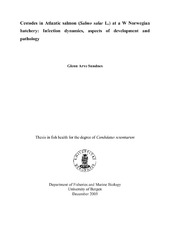| dc.description.abstract | Many cestodes use copepods as first intermediate hosts, and some may infect juvenile salmonids in hatcheries that use water from sources that are inhabited by native salmonids. Little is known about their infection dynamics and development under these artificial conditions. The cestode fauna of juvenile Atlantic salmon (Salmo salar L.) was examined from February (fry) to the end of July (parr) at a hatchery in Hordaland, W Norway. Two fish groups, which followed standard rearing conditions, were studied. These groups received inlet water through filter systems with differing efficiency. Thus the fish groups were infected at different times in spring. Sampling was carried out at bi-weekly intervals, and a total of 1709 juvenile salmon were examined during the study. In addition, a total of 43 wild salmonids (salmon, rainbow trout, charr and brown trout) from the supplying watercourse were examined for the presence of cestodes. Two adult tapeworms, Eubothrium crassum (Bloch, 1779) and Proteocephalus longicollis (Zeder, 1800), and a single Diphyllobothrium dendriticum (Nitzsch, 1824) plerocercoid were found in the juvenile salmon. Eubothrium crassum and P. longicollis were first found in the juvenile salmon in late March. The principal infection with E. crassum occurred from late March to mid May, while infections with P. longicollis mainly took place in two pulses, one in March – April and one in May – June. Prevalence of E. crassum and P. longicollis reached a maximum of 42% and 41%, respectively. A few tapeworms were usually found in each infected salmon. The development time from larva to the gravid state was estimated to 50 days (750 day-degrees) and 33 days (460 day-degrees) for E. crassum and P. longicollis, respectively, suggesting that these cestodes may complete their life cycle in less than a year. Small fish showed higher abundance of E. crassum or P. longicollis than larger fish. Abundance and load (weight worm/weight fish) of E. crassum were negatively correlated with host condition, suggesting that E. crassum may have a negative effect on salmon growth. Proteocephalus longicollis infections appeared to be less harmful. The study highlights the importance of effective filtering of the inlet water in hatcheries, since the evidence suggest that E. crassum interfere with the production of smolts. | en_US |
